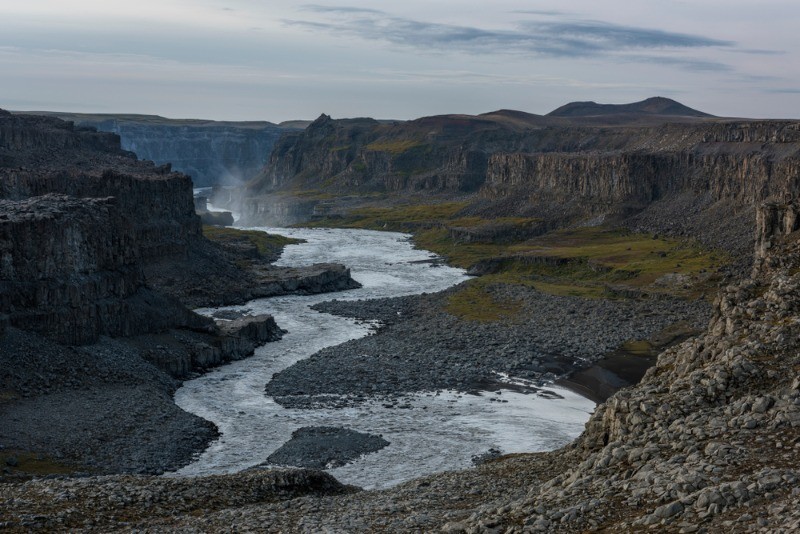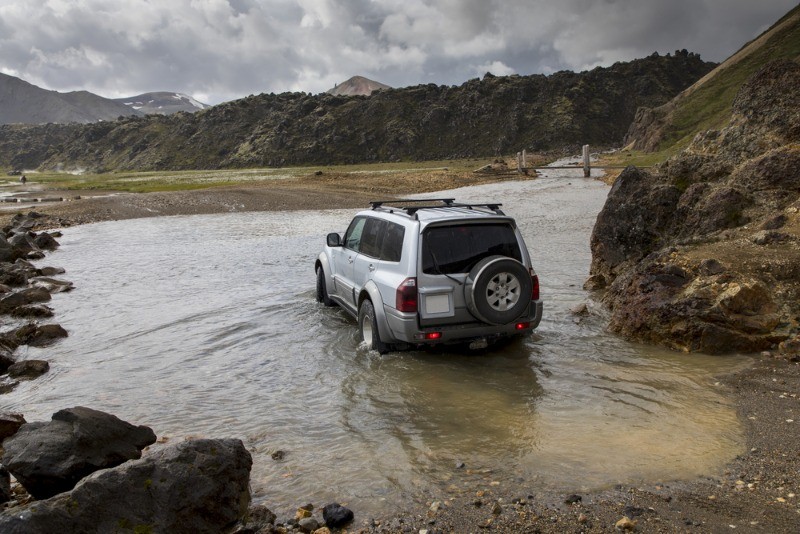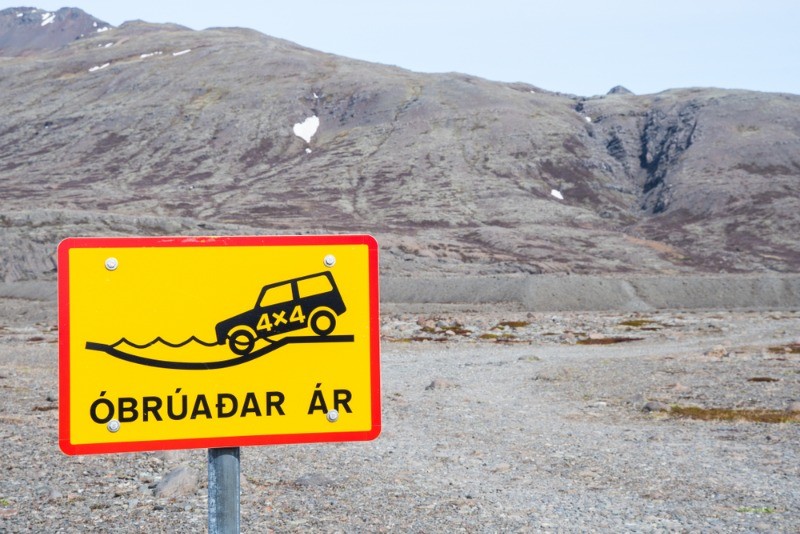There are two things that ensure Iceland has an abundance of freshwater: huge glaciers and high snow- and rainfall. All of this water also creates beautiful features for us to interact with, such as lakes, rivers, and waterfalls. You will come across these features as you explore the country in your rental car. And wherever your adventure takes you, you will be crossing rivers in Iceland.
Main Rivers in Iceland
Even just by traveling around Iceland’s ring road, Route 1, you will pass over some of its greatest rivers. Route 1 passes over the country’s longest river, Þjórsá (translation: Bull River) via a bridge on the south coast.
Þjórsá runs 230km (143 miles) from the center of Iceland to the ocean. Just below the bridge is Urriðafoss, an impressive waterfall. Keep an eye out for it, but please don’t stop on the bridge.
Jökulsá á Fjöllum (translation: Glacial River in the Mountains) is the second-longest river in Iceland. It’s 206km (128 miles) long and flows from the center of Iceland to the north. Route 1 also passes over this river in the north-east, via the ‘Golden Gate Bridge of the Highlands’.
If you’re traveling counter-clockwise around the ring road, you’ll encounter Ölfusá river before Þjórsá. Ölfusá passes by the town of Selfoss in the south-west and is crossed by a suspension bridge along Route 1. This river has the claim of being Iceland’s most voluminous, with an average flow of 423 cubic meters per second.

Hvítá (translation: White River) is short at only 40km (25 miles) long, but it’s famous for two reasons. It’s popular for rafting and fishing and is also the river that feeds Gullfoss, the most famous waterfall in Iceland. This river is also crossed by a road, but a different type of road than Route 1. An F-road, Road F35, passes over Hvítá; see below for details.
In some areas of the country, there are also volcanic rivers. These are created by glacial water flowing over volcanic rock and forming dazzling color displays. Yellow rivers have been seen along the south coast near the town of Hof.
Crossing rivers on F-Roads
Iceland’s population is concentrated on or near its coastlines. The center of the island, the highlands, is mostly uninhabited. However, since it’s so beautiful up there, Icelanders created roads in order to drive into the highlands. These roads are known as F-roads, in which the F stands for fjall, meaning mountain.
The first thing to note is that these roads are only open from June to September. This is because heavy snow in the highlands, among other weather conditions, makes F-roads essentially inaccessible in winter. Even in summer, it’s a good idea to only venture into the highlands when the weather forecast is clear.
F-roads are not paved; they are gravel roads and not regularly maintained like Iceland’s highways. Because of this, Icelandic laws only allow 4WD vehicles to travel on F-roads, and you'll have to rent a 4x4 in Iceland if you plan the visit the more remote areas of the country. It’s wise to follow this rule, as conditions in Iceland’s interior can be dangerous and help is far away. Hvítá river, described above, has an actual bridge passing over it, but many rivers passing through the highlands require fording. How, and whether, you should ford these rivers to reach the top depends on your vehicle, water levels, and currents.
How to Cross Rivers in Iceland
When traveling to the highlands, the first consideration is to check your route is open and safe to travel on. The website Road.is provides you with up to date information on each road in Iceland. If there has been heavy rainfall or snowfall near to the F-road on your route, fording may be impossible. Additionally, Iceland’s slowly melting glaciers mean that at times, rivers passing over F-roads may shift. If you know that your route requires river fording, it’s best to rent a Jeep for your Iceland road trip or get some other raised car. Also, basic insurance with many rental car companies in Iceland doesn’t cover water damage, so you may want to purchase extra.

So, what is the safest way to cross a river?
Firstly, you should only cross where directed. These crossing points have been carefully selected, so don’t think you can find a better place to cross. Driving off-road is illegal in Iceland, so stick to the path. Also, don’t drive too fast. If the water splashes over your bonnet or windscreen, you need to slow down. Use a low gear and don’t change gears while you are in the water. It’s recommended to cross at a slight angle, with the front of your vehicle facing downstream.
A rule is that if the river is too dangerous to wade in, it’s too dangerous to drive across. The water should not reach the top of the tires. If it does, or if you have a feeling that trying to cross is not a good idea, turn back. There are plenty of places to drive to only a few hours from Reykjavík, so have a plan B. Rivers that were safe to cross yesterday may not be safe to cross today.
What’s in the Highlands?
All of this information may have made highland adventures sound scary, but don’t be alarmed. While only experienced drivers with suitable vehicles should head up there, specially designed buses can also take you up. However you’re getting to the highlands, it’s well worth the trip. The views both on the way and at your destination are remarkable; huge stretches of untouched nature.

Lava fields, volcanoes, glaciers, and rivers make the highlands a feast of geological features. A popular place for both tourists and locals to visit is Landmannalaugar. A campsite is established here every summer to accommodate the hikers who pass through on the Laugavegur Trail. But Landmannalaugar could even be squeezed into a day trip, and there’s much to see. Natural geothermal pools are in abundance, as are the famous multi-colored rhyolite mountains, formed by mineral deposits.
Other Safety Tips for Iceland
Iceland’s weather is famously unpredictable, so always have warm, waterproof clothing with you. You can check the weather forecast here. You shouldn’t have too many problems in summer, but from October to April strong wind and snowstorms are common. Some of Iceland’s tunnels and bridges are single lane, so approach these cautiously and be considerate towards other drivers. Because of Iceland’s location, expect almost 24 hours of daylight in summer and the opposite in the winter. This has its benefits: in summer your adventure can last longer without darkness to stop you. And in winter you have more northern lights opportunities without the Sun getting in the way.

Whether you’re heading over a bridge or fording, crossing rivers is bound to be part of your Iceland experience. They are integral to Iceland’s wildlife, and many species of fish and birds are drawn to our rivers. You may even get lucky and see some seals, who are adapted to swimming and hunting in our cold waters. Additionally, due to the country’s low population, we have some of the cleanest water in the world. Help preserve Iceland’s pristine nature by adopting sustainable practices while you’re here. Take nothing but pictures, leave nothing but footprints. Enjoy the beauty that the land of ice and fire has to offer.


 By
By


